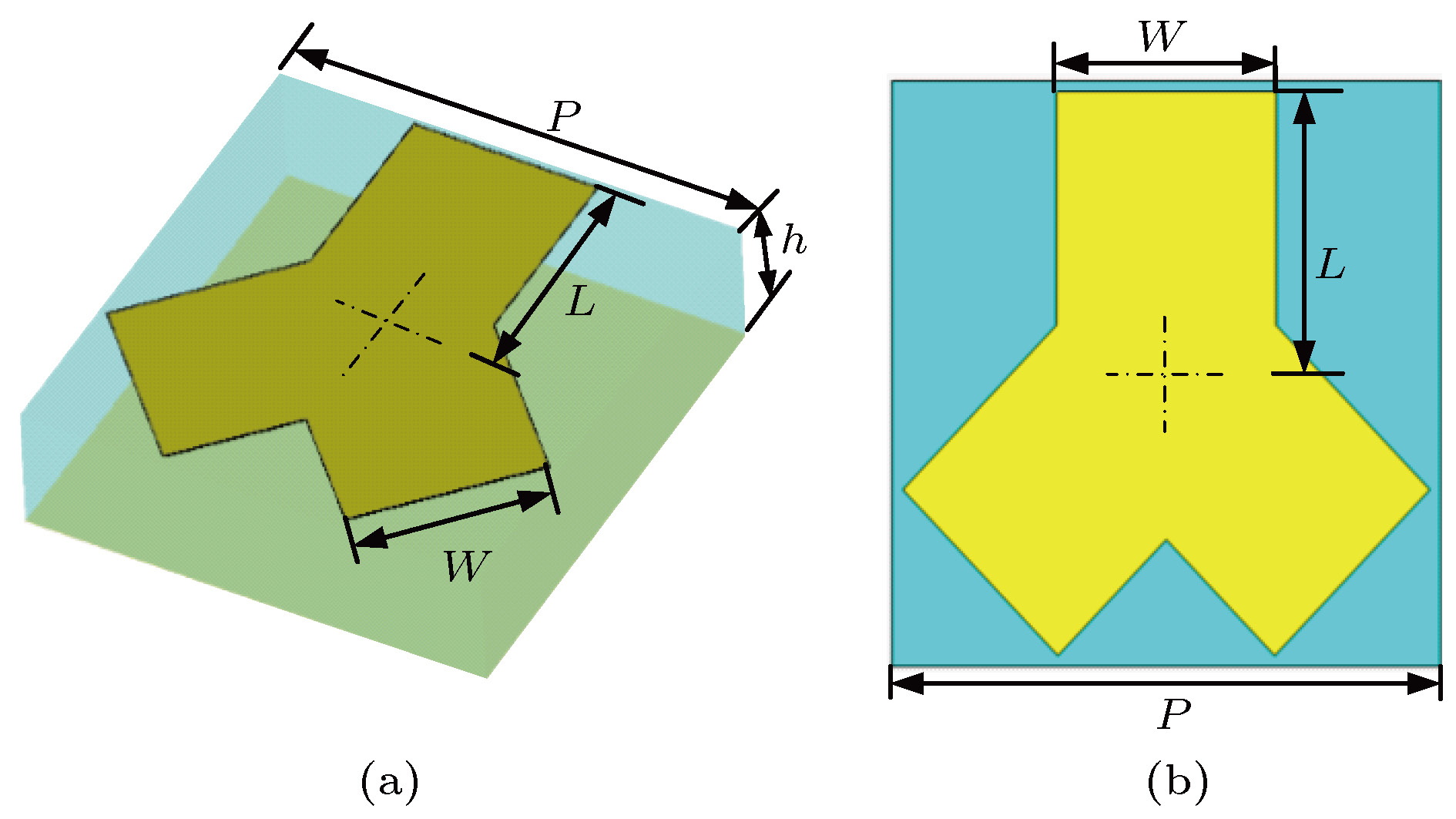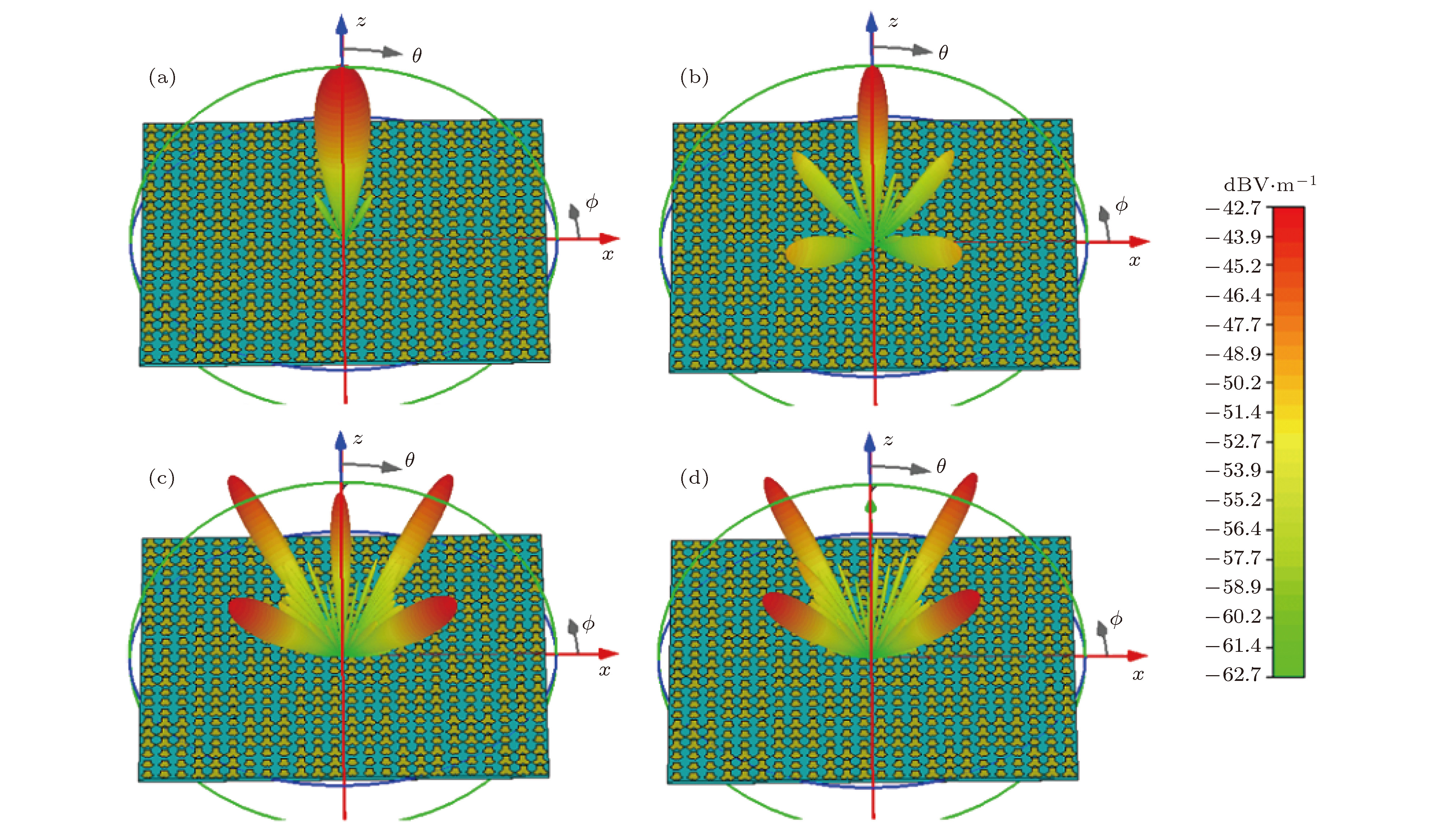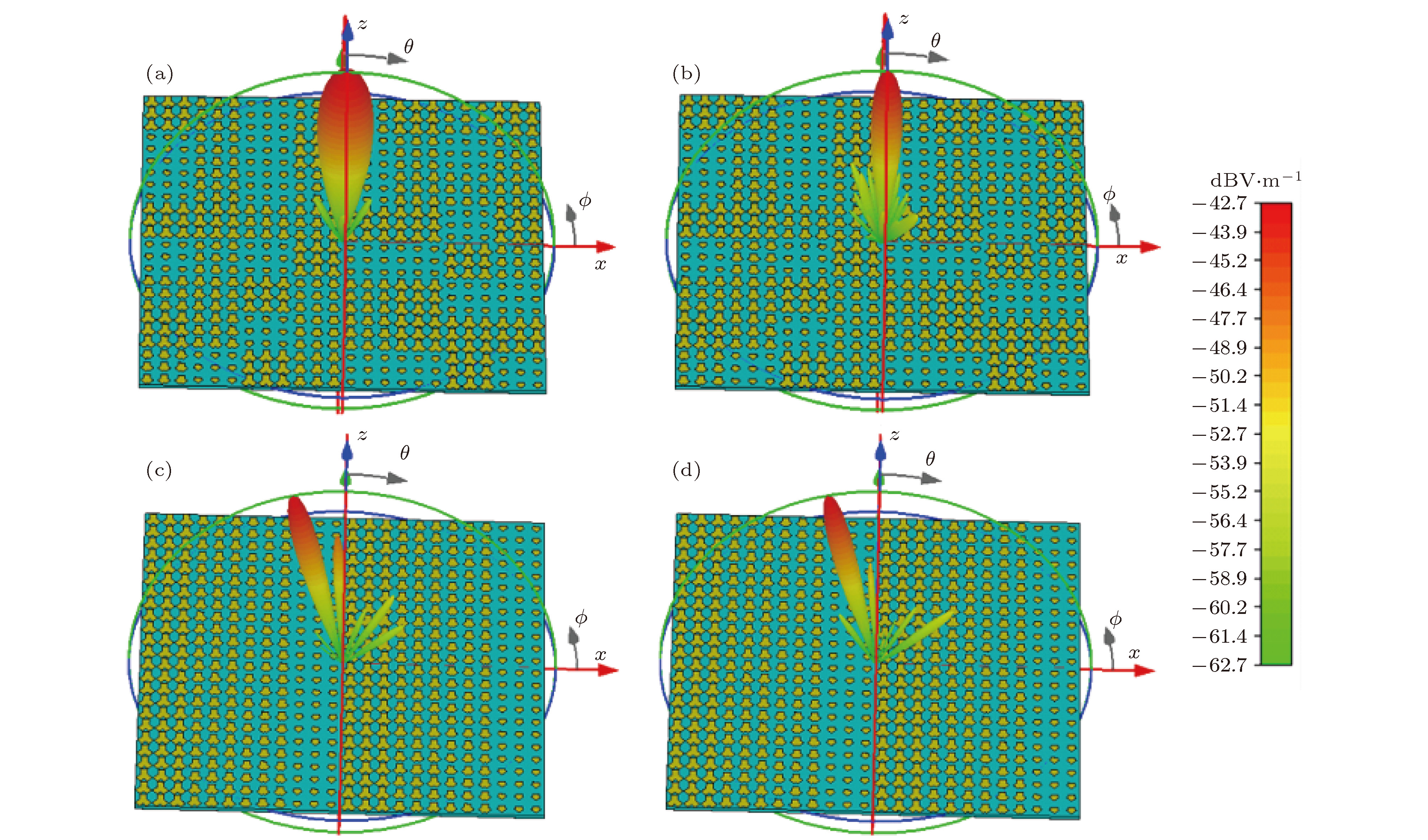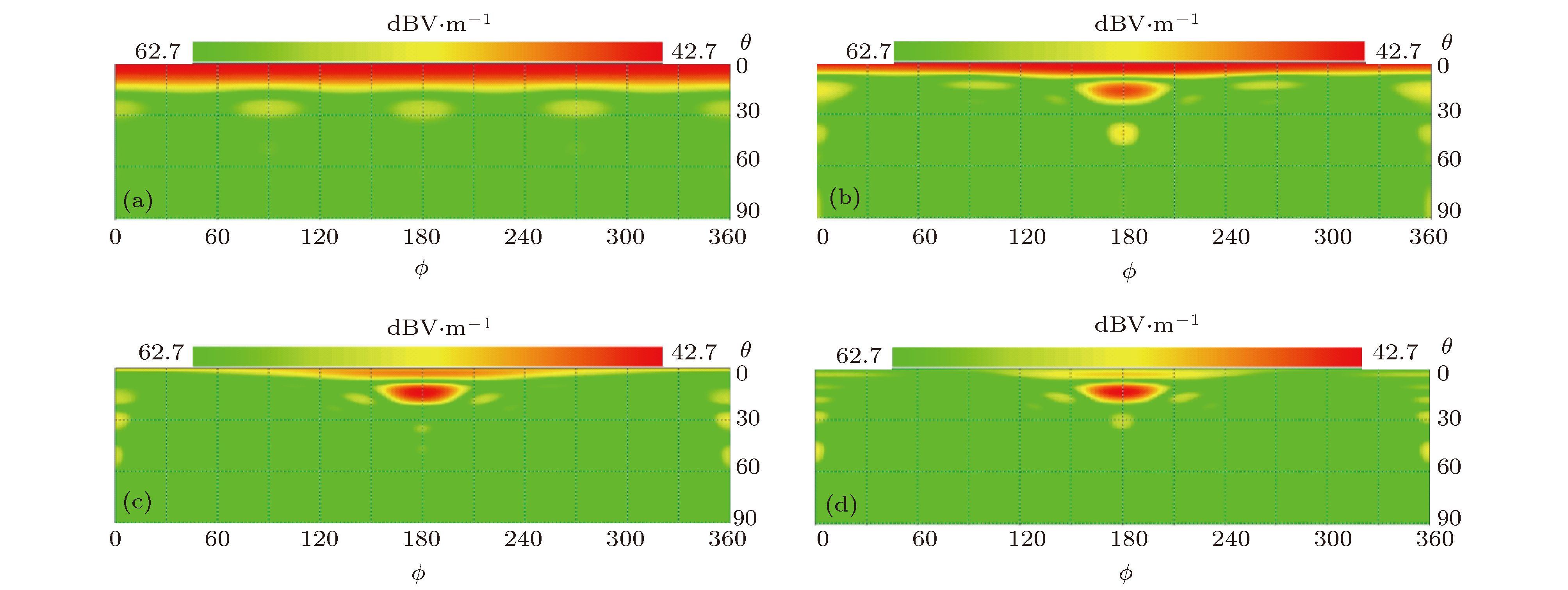-
Metasurface is an artificial structure composed of sub-wavelength units which can realize the arbitrary control of electromagnetic wave energy by coding and arranging metasurface. Unlike the previous coding metasurface with a fixed phase difference of the neighbor coding unit cells, the frequency coding metasurface possesses the main feature that it has the linear change phase difference and different phase sensitivities in the whole working frequency band of the digital unit cells. And it can flexibly control the reflected terahertz waves to the numerous directions by changing the working frequency without redesigning the coding metasurface structure. In this paper, the frequency coding metasurfaces are designed by using four herringbone unit cells with the same shape and different sizes. They have the same phase response at the initial frequency and the different phase sensitivities throughout the frequency band. To describe the frequency coding characteristics of the unit cells, the digital numbers "0" and "1" are used to represent the low phase sensitivity and high phase sensitivity, respectively. Using the frequency digital coding, it can control the electromagnetic wave energy radiations by a single digital coding metasurface without changing the spatial coding pattern. By the combination of the spatial coding and frequency coding, It can manipulate the electromagnetic wave energy radiations more flexibly. We demonstrate 1-bit, 2-bit periodic frequency coding metasurfaces and 2-bit non-periodic frequency coding metasurface. They are all designed in the pre-designed coding sequence to control the electromagnetic wave energy radiations. Numerically simulated results confirm that the frequency coding metasurface can flexibly control the reflected terahertz waves to the numerous directions by changing the working frequency without redesigning the coding metasurface structure. Additionally, the number of the backward diffusion-like scattering beam increases with the change of frequency for the 2-bit random terahertz frequency coding metasurface. It has a good dispersion effect on the main lobe energy of terahertz wave radiation. The radar cross section can be reduced effectively, and the maximum value of radar cross section reduction can reach 29 dB in the direction of θ = 0, φ = 0. It has a great application value in the terahertz wave cloaking.
-
Keywords:
- coding metasurface /
- terahertz manipulation /
- phase sensitivity
[1] Yu N F, Genevet P, Kats M A, Aieta F, Tetienne P J, Capasso F, Gaburro Z 2011 Science 334 333
 Google Scholar
Google Scholar
[2] Yu N F,Capasso F 2014 Nat. Mater. 13 139
 Google Scholar
Google Scholar
[3] Liu L X, Zhang X Q, Kenney M, Su X Q, Xu N N, Ouyang C M, Shi Y L, Han J G, Zhang W L, Zhang S 2014 Adv. Mater. 26 5031
 Google Scholar
Google Scholar
[4] Li Y F, Zhang J Q, Qu S B, Wang J F, Chen H Y, Xu Z, Zhang A X 2014 J. Appl. Phys. 115 063908
 Google Scholar
Google Scholar
[5] Yu Y F, Zhu A Y, Paniagua-Domínguez R, Fu Y H, Luk'Yanchuk B, Kuznetsov A I 2015 Laser Photon. Rev. 9 412
 Google Scholar
Google Scholar
[6] Li Y F, Zhang J Q, Qu S B, Wang J F, Zheng L, Pang Y Q, Xu Z, Zheng A X 2015 J. Appl. Phys. 117 044501
 Google Scholar
Google Scholar
[7] Zhu H F, Semperlotti F 2016 Phys. Rev. Lett. 117 034302
 Google Scholar
Google Scholar
[8] Wang L, Kruk S, Tang H Z, Li T, Kravchenko I, Neshev D N, Kivshar Y S 2016 Optica 3 1504
 Google Scholar
Google Scholar
[9] Li Y F, Zhang J Q, Qu S B, Wang J F, Chen H Y, Xu Z, Zhang A X 2014 Appl. Phys. Lett. 104 221110
 Google Scholar
Google Scholar
[10] Ramli M N, Ping J S, Jamlos M F, Lago H, Aziz N M, Al-Hadi A A 2017 Appl. Phys. A 123 149
 Google Scholar
Google Scholar
[11] Xu H X, Wang G M, Liang J G, Qi M Q, Gao X 2013 IEEE Trans. Antennas Propag. 61 3442
 Google Scholar
Google Scholar
[12] Wan X, Shen X P, Luo Y, Cui T J 2014 Laser Photon. Rev. 8 757
 Google Scholar
Google Scholar
[13] Li Z L, Kim I, Zhang L, Mehmood M Q, Anwar M S, Saleem M, Lee D, Nam K T, Zhang S, Luk'Yanchuk B, Wang Y, Zheng G X, Rho J, Qiu C W 2017A CS Nano 11 9382
 Google Scholar
Google Scholar
[14] Cui TJ, Liu S, Li L L 2016 Light Sci. Appl. 5 e16172
 Google Scholar
Google Scholar
[15] Huang C, Sun B, Pan W B, Cui J H, Wu X Y, Luo X G 2017 Sci. Rep. 7 42302
 Google Scholar
Google Scholar
[16] Li J S, Zhao Z J, Yao J Q 2017 Opt. Express 25 29983
 Google Scholar
Google Scholar
[17] Cui T J, Liu S 2017 Adv. Opt. Mater. 5 1700624
 Google Scholar
Google Scholar
[18] Li L L, Cui T J, Ji W, Liu S, Ding J, Wan X, Li Y B, Jiang M H, Qiu C W, Zhang S 2017 Nat. Commun. 8 197
 Google Scholar
Google Scholar
[19] Su J X, Cui Y Y, Li Z R, Yan Q L, Che Y X, Yin H C 2018 AIP Adv. 8 035027
 Google Scholar
Google Scholar
[20] Li J S, Yao J Q 2018 IEEE Photon. J. 10 1
 Google Scholar
Google Scholar
-
图 2 4种人字形超表面基本单元结构及其特性曲线 (a) A单元(L = 48 μm); (b) B单元(L = 40 μm); (c) C单元(L = 34 μm); (d) D单元(L = 20 μm); (e) 4种单元在0.4 THz到1.0 THz下的反射率; (f) 4种单元在0.4 THz到1.0 THz下的反射相位
Figure 2. The basic unit structure and characteristic curves of four kinds of herringbone metasurface: (a) Unit A (L = 48 μm); (b) unit B (L = 40 μm); (c) unit C (L = 34 μm); (d) unit D (L = 20 μm); (e) reflectivity of four unitsfrom 0.4 THz to 1.0 THz; (f) reflection phase of four units from 0.4 THz to 1.0 THz.
图 3 太赫兹频率编码器 (a)以“0-0, 0-1, 0-0, 0-1”序列沿x方向排列1-bit周期太赫兹频率编码器; (b)棋盘式1-bit周期太赫兹频率编码器; (c)以“00-00, 00-01, 00-10, 00-11”序列沿x方向排列2-bit周期太赫兹频率编码器; (d) 2-bit随机太赫兹频率编码器; (e) 2-bit非周期太赫兹频率编码器
Figure 3. The terahertz frequency coding metasurface: (a) 1-bit periodic terahertz frequency coding metasurface arranged along x direction with “0-0, 0-1, 0-0, 0-1” sequence; (b) chessboard 1-bit periodic terahertz frequency coding metasurface; (c) 2-bit periodic terahertz frequency coding metasurface arranged along x direction with “00-00, 00-01, 00-10, 00-11” sequence; (d) 2-bit random terahertz frequency coding metasurface; (e) 2-bit non-periodic terahertz frequency coding metasurface.
图 4 序列“0-0, 0-1, 0-0, 0-1”沿x方向上周期排布的1-bit太赫兹频率编码器 (a) f = 0.4 THz, (b) f = 0.75 THz, (c) f = 0.95 THz, (d) f = 1.0 THz时的三维远场图
Figure 4. 1-bit terahertz frequency coding metasurface arranged periodically along x direction with sequence “0-0,0-1, 0-0, 0-1”: Three-dimensional far-field pattern of (a) f = 0.4 THz, (b) f = 0.75 THz, (c) f = 0.95 THz, (d) f = 1.0 THz.
图 5 序列“0-0, 0-1, 0-0, 0-1”沿x方向上周期排布的1-bit太赫兹频率编码器 (a) f = 0.4 THz, (b) f = 0.75 THz, (c) f = 0.95 THz, (d) f = 1.0 THz时的二维电场图
Figure 5. 1-bit terahertz frequency coding metasurface arranged periodically along x direction with sequence“0-0, 0-1, 0-0, 0-1”: Two-dimensional electric field pattern of (a) f = 0.4 THz, (b) f = 0.75 THz, (c) f = 0.95 THz, (d) f = 1.0 THz.
图 8 “00-00, 00-01, 00-10, 00-11”周期排布的2-bit太赫兹频率编码器 (a) f = 0.4 THz, (b) f = 0.75 THz, (c) f = 0.95 THz, (d) f = 1.0 THz时的三维远场图
Figure 8. 2-bit periodic terahertz frequency coding metasurfacearranged along x direction with “00-00, 00-01, 00-10, 00-11” sequence: Three-dimensionalfar-field pattern of (a) f = 0.4 THz, (b) f = 0.75 THz, (c) f = 0.95 THz, (d) f = 1.0 THz.
图 9 “00-00, 00-01, 00-10, 00-11”周期排布的2-bit太赫兹频率编码器 (a) f = 0.4 THz, (b) f = 0.75 THz, (c) f = 0.95 THz, (d) f = 1.0 THz时的二维电场图
Figure 9. 2-bit periodic terahertz frequency coding metasurface arranged along x direction with “00-00, 00-01, 00-10, 00-11” sequence: Two-dimensionalelectric field pattern of (a) f = 0.4 THz, (b) f = 0.75 THz, (c) f = 0.95 THz, (d) f = 1.0 THz.
表 1 1-bit频率编码器单元
Table 1. 1-bit frequency terahertz coding metasurface unit.
单元结构 α0/(°) 1-bit相位响应 近似α0/(°) 空域码 α1/(°)·THz–1 近似α1/(°)·THz–1 频域码 编码状态 154 160 “0” –312/0.6 0/0.6 “0” “0–0” 158 160 “0” –138/0.6 180/0.6 “1” “0–1” -
[1] Yu N F, Genevet P, Kats M A, Aieta F, Tetienne P J, Capasso F, Gaburro Z 2011 Science 334 333
 Google Scholar
Google Scholar
[2] Yu N F,Capasso F 2014 Nat. Mater. 13 139
 Google Scholar
Google Scholar
[3] Liu L X, Zhang X Q, Kenney M, Su X Q, Xu N N, Ouyang C M, Shi Y L, Han J G, Zhang W L, Zhang S 2014 Adv. Mater. 26 5031
 Google Scholar
Google Scholar
[4] Li Y F, Zhang J Q, Qu S B, Wang J F, Chen H Y, Xu Z, Zhang A X 2014 J. Appl. Phys. 115 063908
 Google Scholar
Google Scholar
[5] Yu Y F, Zhu A Y, Paniagua-Domínguez R, Fu Y H, Luk'Yanchuk B, Kuznetsov A I 2015 Laser Photon. Rev. 9 412
 Google Scholar
Google Scholar
[6] Li Y F, Zhang J Q, Qu S B, Wang J F, Zheng L, Pang Y Q, Xu Z, Zheng A X 2015 J. Appl. Phys. 117 044501
 Google Scholar
Google Scholar
[7] Zhu H F, Semperlotti F 2016 Phys. Rev. Lett. 117 034302
 Google Scholar
Google Scholar
[8] Wang L, Kruk S, Tang H Z, Li T, Kravchenko I, Neshev D N, Kivshar Y S 2016 Optica 3 1504
 Google Scholar
Google Scholar
[9] Li Y F, Zhang J Q, Qu S B, Wang J F, Chen H Y, Xu Z, Zhang A X 2014 Appl. Phys. Lett. 104 221110
 Google Scholar
Google Scholar
[10] Ramli M N, Ping J S, Jamlos M F, Lago H, Aziz N M, Al-Hadi A A 2017 Appl. Phys. A 123 149
 Google Scholar
Google Scholar
[11] Xu H X, Wang G M, Liang J G, Qi M Q, Gao X 2013 IEEE Trans. Antennas Propag. 61 3442
 Google Scholar
Google Scholar
[12] Wan X, Shen X P, Luo Y, Cui T J 2014 Laser Photon. Rev. 8 757
 Google Scholar
Google Scholar
[13] Li Z L, Kim I, Zhang L, Mehmood M Q, Anwar M S, Saleem M, Lee D, Nam K T, Zhang S, Luk'Yanchuk B, Wang Y, Zheng G X, Rho J, Qiu C W 2017A CS Nano 11 9382
 Google Scholar
Google Scholar
[14] Cui TJ, Liu S, Li L L 2016 Light Sci. Appl. 5 e16172
 Google Scholar
Google Scholar
[15] Huang C, Sun B, Pan W B, Cui J H, Wu X Y, Luo X G 2017 Sci. Rep. 7 42302
 Google Scholar
Google Scholar
[16] Li J S, Zhao Z J, Yao J Q 2017 Opt. Express 25 29983
 Google Scholar
Google Scholar
[17] Cui T J, Liu S 2017 Adv. Opt. Mater. 5 1700624
 Google Scholar
Google Scholar
[18] Li L L, Cui T J, Ji W, Liu S, Ding J, Wan X, Li Y B, Jiang M H, Qiu C W, Zhang S 2017 Nat. Commun. 8 197
 Google Scholar
Google Scholar
[19] Su J X, Cui Y Y, Li Z R, Yan Q L, Che Y X, Yin H C 2018 AIP Adv. 8 035027
 Google Scholar
Google Scholar
[20] Li J S, Yao J Q 2018 IEEE Photon. J. 10 1
 Google Scholar
Google Scholar
Catalog
Metrics
- Abstract views: 10125
- PDF Downloads: 170
- Cited By: 0















 DownLoad:
DownLoad:













